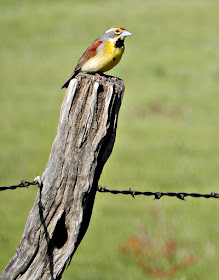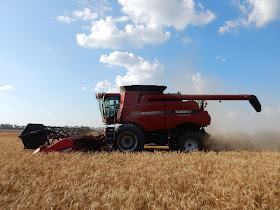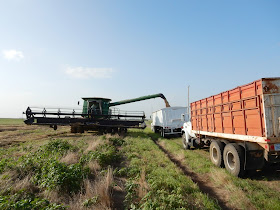 |
| Grand Champion, Stafford County Fair 2016 open class |
"It's just one person's opinion on one day."
It's a phrase my parents often repeated. They said it at music festivals while I anxiously waited for the rating on my vocal solo to be posted. They repeated it during the county fair. With a stomach turning somersaults and my fingers anxiously tapping a nervous rhythm, I probably inwardly rolled my eyes. (I didn't outwardly do it: I would have gotten in trouble.)
But you know what? It's true. Judging is one person's opinion on one day.
So if people at the Stafford County Fair looked at the Grand Champion ribbon taped to my photo last week and thought, "I wonder why they picked that one?" That's why: It was one person's opinion on one day.
Of all the photos I entered, I wouldn't have chosen that one as my favorite either. It was probably among my most unusual though, and sometimes uniqueness counts.
I took the photo last March at Pratt Livestock when we sold feeder calves. We had been at the sale barn all day long. But when we stepped outside into the darkness, I noticed the country version of a traffic jam. Randy wasn't surprised when I delayed our departure a little longer to get a few shots of the cattle trucks lined up around the perimeter of the sale barn parking lot.
I entered a bunch of photos in the open class division of the county fair last week. Old habits die hard.

I've been exhibiting things at county fairs since I was 10 years old. I
was a fourth grader and a member of the Lincoln Bluebirds 4-H Club.
My
only project my first year was "Snacks and Little Lunches," a foods and
nutrition project. According to my meticulous record book, my first
fair netted a blue ribbon on cookies and red ribbons on both my cupcakes
and brownies.
If my 4-H story is to be believed, I had a "lot
of fun." In fact, several times, I had "a lot of fun." Perhaps my
descriptive writing had not yet been developed.
But, at any
rate, I evidently did have "a lot of fun." Here we are ... um ...
several years later, and I'm still entering exhibits in county fairs.
In open class at the Stafford County Fair, not every photo gets a ribbon. I had several blues, along with some reds and whites. And I had some that didn't place at all.
 |
| Blue ribbon in "People" category |
My premium money didn't begin to cover the cost of enlarging
photos, buying mat board and special plastic bags, but I felt pretty good
about having more than half of my photos "in the money," so to speak.
 |
| Blue ribbon in "Animal" category |
However, it's
not about the money. It's about being part of something bigger. If
people don't enter, there's nothing to look at during the fair. And if
there's nothing to look at, nobody is going to come. And if no one
comes, fairs are going to die.
 |
| Blue ribbon in the "Landscape/Scenic" category |
Because of a decreasing population
base, there are already fewer exhibits than there were back when I was a
kid. Or maybe it's just a shift in the kind of 4-H projects kids take
today. Back in my day, there were lots of little girls in clothing
construction. Today, very few 4-Hers construct their own clothing or
other items. There are no longer racks of home-sewn clothing hanging at
county fairgrounds.
 |
| Blue ribbon, "Human Interest" category, Black and White |
But photography seems to be alive and well. There were lots of entries in both the 4-H and open class divisions.
 |
| Blue ribbon, B/W, "Action" category |
Because of blogging, I seem to grab the camera more often. So I have a lot of photos to choose from.
 |
| Blue ribbon, "Humor" category |
For the record, one of my favorite photos, a sunrise over a wheat field,
got a red ribbon. That particular photo had gotten more than 500
"likes" on Snapshot Kansas' Facebook page. So you just can't outguess a judge: "It's one person's opinion on one day."
So here we are, back to the question at hand: Why exhibit at the county fair? People
have been experiencing fairs since the days of the Roman empire (At
least that's what Wikipedia - the authority of all things - told me). I
suppose there's a little rush to being chosen "best" at something,
satisfying that little kernel of competitiveness in the human spirit.
But
I truly think it's about helping to make sure fairs last another 2,000
years. (Maybe women in Jerusalem met in the city square while gathering
water and decided who had the best flat bread. Yes, I know I have a
vivid imagination.)
Fairs give people an excuse to come together, to visit with people they don't see everyday.
It
gives guys an opportunity to eat food their wives won't fix them at
home everyday (Yes, I think Randy had pie every day he was there.)
It brings volunteers together to work on something that's bigger than what any one person could accomplish on their own.
It's about being part of a community. I'll give that a purple ribbon any day.
And speaking of purple ribbons, I also got a pretty lavender Reserve Grand Champion ribbon in the arts and crafts division with my children's book,
Count on It! Adventures from a Kansas Farm.
I used my photography and created rhyming verses for the numbers 1 to 20 and self-published it on
Heritage Makers. I dedicated the book to our granddaughters, Kinley and Brooke, and to "other children in an effort to keep our rural heritage strong."
I'd like to pursue getting it published by an actual publisher, so I could sell them at a lower price, but that's easier said than done. Still, it's nice to have someone say, "Job well done!" Even if it's only one person's opinion on one day.























































